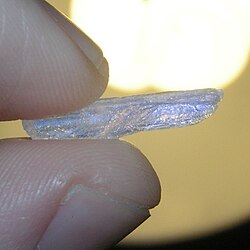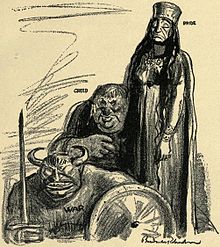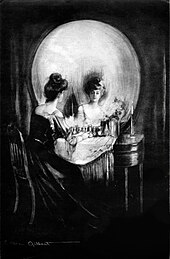Playing can induce an intense state of happiness and contentment, like this young girl playing in the snow.
Euphoria ( /juːˈfɔːriə/) is the experience (or affect) of pleasure or excitement and intense feelings of well-being and happiness. Certain natural rewards and social activities, such as aerobic exercise, laughter, listening to or making music, and dancing, can induce a state of euphoria. Euphoria is also a symptom of certain neurological or neuropsychiatric disorders, such as mania. Romantic love and components of the human sexual response cycle are also associated with the induction of euphoria. Certain drugs, many of which are addictive, can cause euphoria, which at least partially motivates their recreational use.
Hedonic hotspots
– i.e., the pleasure centers of the brain – are functionally linked.
Activation of one hotspot results in the recruitment of the others.
Inhibition of one hotspot results in the blunting of the effects of
activating another hotspot. Therefore, the simultaneous activation of every hedonic hotspot within the reward system is believed to be necessary for generating the sensation of an intense euphoria.
History of the term
The word "euphoria" is derived from the Ancient Greek terms εὐφορία: εὖ eu meaning "well" and φέρω pherō meaning "to bear". It is semantically opposite to dysphoria.
A 1706 English dictionary
defines euphoria as "the well bearing of the Operation of a Medicine,
i.e., when the patient finds himself eas'd or reliev'd by it".
In the 1860s, the English physician Thomas Laycock described euphoria as the feeling of bodily well-being and hopefulness; he noted its misplaced presentation in the final stage of some terminal illnesses and attributed such euphoria to neurological dysfunction. Sigmund Freud's 1884 monograph Über Coca described (his own) consumption of cocaine producing "the normal euphoria of a healthy person", while about 1890 the German neuropsychiatrist Carl Wernicke lectured about the "abnormal euphoria" in patients with mania.
A 1903 article in The Boston Daily Globe refers to euphoria as "pleasant excitement" and "the sense of ease and well-being". In 1920 Popular Science
magazine described euphoria as "a high sounding name" meaning "feeling
fit": normally making life worth living, motivating drug use, and ill
formed in certain mental illnesses. Robert S. Woodworth's 1921 textbook Psychology: A study of mental life, describes euphoria as an organic state which is the opposite of fatigue, and "means about the same as feeling good."
In 1940 The Journal of Psychology defined euphoria as a "state of general well being ... and pleasantly toned feeling." A decade later, finding ordinary feelings of well being difficult to evaluate, American addiction researcher Harris Isbell redefined euphoria as behavioral changes and objective signs typical of morphine. However, in 1957 British pharmacologist D. A. Cahal did not regard opioid euphoria as medically undesirable but an effect which "enhance[s] the value of a major analgesic." The 1977 edition of A Concise Encyclopaedia of Psychiatry called euphoria "a mood of contentment
and well-being," with pathologic associations when used in a
psychiatric context. As a sign of cerebral disease, it was described as
bland and out of context, representing an inability to experience
negative emotion.
In the 21st century, euphoria is generally defined as a
state of great happiness, well-being and excitement, which may be
normal, or abnormal and inappropriate when associated with psychoactive
drugs, manic states, or brain disease or injury.
Neural substrates
Hedonic hotspots
– i.e., the pleasure centers of the brain – are functionally linked.
Activation of one hotspot results in the recruitment of the others.
Inhibition of one hot spot results in the blunting of the effects of
activating another hotspot.
Therefore, the simultaneous activation of every hedonic hotspot within
the reward system is believed to be necessary for generating the
sensation of euphoria.
Types
Many different types of stimuli can induce euphoria, including psychoactive drugs, natural rewards, and social activities. Affective disorders such as unipolar mania or bipolar disorder can involve euphoria as a symptom.
Exercise-induced
Runners can experience a euphoric state often called a "runner's high".
Continuous physical exercise, particularly aerobic exercise, can induce a state of euphoria; for example, distance running is often associated with a "runner's high", which is a pronounced state of exercise-induced euphoria. Exercise is known to affect dopamine signaling in the nucleus accumbens, producing euphoria as a result, through increased biosynthesis of three particular neurochemicals: anandamide (an endocannabinoid), β-endorphin (an endogenous opioid), and phenethylamine (a trace amine and amphetamine analog).
Music euphoria
Euphoria can occur as a result of dancing to music, music-making, and listening to emotionally arousing music. Neuroimaging studies have demonstrated that the reward system plays a central role in mediating music-induced pleasure. Pleasurable emotionally arousing music strongly increases dopamine neurotransmission in the dopaminergic pathways that project to the striatum (i.e., the mesolimbic pathway and nigrostriatal pathway). Approximately 5% of the population experiences a phenomenon termed "musical anhedonia",
in which individuals do not experience pleasure from listening to
emotionally arousing music despite having the ability to perceive the
intended emotion that is conveyed in passages of music.
Copulation-induced
The
various stages of copulation may also be described as inducing euphoria
in some people. Various analysts have described either the entire act
of copulation, the moments leading to orgasm, or the orgasm itself as
the pinnacle of human pleasure or euphoria.
Drug-induced
A large dose of methamphetamine causes a drug-induced euphoria.
A euphoriant is a type of psychoactive drug which tends to induce euphoria. Most euphoriants are addictive drugs due to their reinforcing properties and ability to activate the brain's reward system.
Stimulants
Dopaminergic stimulants like amphetamine, methamphetamine, cocaine, MDMA, and methylphenidate are euphoriants. Nicotine is a parasympathetic stimulant that acts as a mild euphoriant in some people.
Some textbooks state that caffeine is a mild euphoriant, others state that it is not a euphoriant, and one states that it is and is not a euphoriant.
Chewing areca nut (seeds from the Areca catechu palm) with slaked lime (calcium hydroxide) – a common practice in South- and Southeast Asia – produces stimulant effects and euphoria. The major psychoactive ingredients – arecoline (a muscarinic receptor partial agonist) and arecaidine (a GABA reuptake inhibitor) – are responsible for the euphoric effect.
Depressants
Certain depressants can produce euphoria; some of the euphoriant drugs in this class include alcohol in moderate doses, γ-hydroxybutyric acid, and ketamine.
Some barbiturates and benzodiazepines may cause euphoria. Euphoriant effects are determined by the drug's speed of onset, increasing dose, and with intravenous administration. Barbiturates more likely to cause euphoria include amobarbital, secobarbital and pentobarbital. Benzodiazepines more likely to cause euphoria are flunitrazepam, alprazolam and clonazepam. Benzodiazepines also tend to enhance opioid-induced euphoria.
Pregabalin induces dose-dependent euphoria. Occurring in a small percentage of individuals at recommended doses, euphoria is increasingly frequent at supratherapeutic doses (or with intravenous- or nasal administration). At doses five times the maximum recommended, intense euphoria is reported. Another GABA analogue, gabapentin, may induce euphoria.
Characterized as opioid-like but less intense, it may occur at
supratherapeutic doses, or in combination with other drugs, such as
opioids or alcohol. Ethosuximide and perampanel can also produce euphoria at therapeutic doses.
Opioids
µ-Opioid receptor agonists are a set of euphoriants that include drugs such as heroin, morphine, codeine, oxycodone, and fentanyl. By contrast, κ-opioid receptor agonists, like the endogenous neuropeptide dynorphin, are known to cause dysphoria, a mood state opposite to euphoria that involves feelings of profound discontent.
Cannabinoids
Cannabinoid receptor 1 agonists are a group of euphoriants that includes certain plant-based cannabinoids (e.g., THC from the cannabis plant), endogenous cannabinoids (e.g., anandamide), and synthetic cannabinoids.
Inhalants
Certain gases, like nitrous oxide (N2O, aka "laughing gas"), can induce euphoria when inhaled.
Glucocorticoids
Acute exogenous glucocorticoid administration is known to produce euphoria, but this effect is not observed with long-term exposure.
Fasting–induced
Fasting
has been associated with improved mood, well-being, and sometimes
euphoria. Various mechanisms have been proposed and possible
applications in treating depression considered.
Asphyxia-induced
Asphyxiation initially produces an extreme feeling of euphoria leading some people to intentionally induce temporary asphyxiation. Erotic asphyxiation typically employs strangulation to produce euphoria which enhances masturbation and orgasm. The choking game, prevalent in adolescents, uses brief hypoxia in the brain to achieve euphoria. Strangulation, or hyperventilation followed by breath holding are commonly used to achieve the effects. Accidental deaths occur from both practices but are often mislabeled as suicide.
Neuropsychiatric
Mania
Euphoria is also strongly associated with both hypomania and mania,
mental states characterized by a pathological heightening of mood,
which may be either euphoric or irritable, in addition to other
symptoms, such as pressured speech, flight of ideas, and grandiosity.
Although hypomania and mania are syndromes with multiple etiologies (that is, ones that may arise from any number of conditions), they are most commonly seen in bipolar disorder, a psychiatric illness characterized by alternating periods of mania and depression.
Epilepsy
Euphoria may occur during auras of seizures typically originating in the temporal lobe, but affecting the anterior insular cortex. This euphoria is symptomatic of a rare syndrome called ecstatic seizures, often also involving mystical experiences. Euphoria (or more commonly dysphoria) may also occur in periods between epileptic seizures. This condition, interictal dysphoric disorder, is considered an atypical affective disorder.
Persons who experience feelings of depression or anxiety between or
before seizures occasionally experience euphoria afterwards.
Migraine
Some persons experience euphoria in the prodrome – hours to days before the onset – of a migraine headache. Similarly, a euphoric state occurs in some persons following the migraine episode.
Multiple sclerosis
Euphoria sometimes occurs in persons with multiple sclerosis as the illness progresses. This euphoria is part of a syndrome originally called euphoria sclerotica, which typically includes disinhibition and other symptoms of cognitive and behavioral dysfunction.











